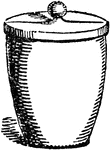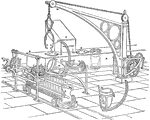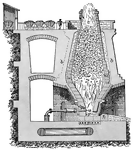Search for "crucible"

Furnace
"The section and ground plan of one of the older forms of open-mouthed furnaces used at Dowlais (Truran),…
!["A verticle section of one form of blast-furnace is represented [here]. the crucible (C) is the part of the furnace in which the molten matte and slag collect. The body of the furnace consists of two concentric shells (cs), made either of wrought iron or of steel, between which cold water (W) is caused to circulate to precent the inner shell becoming heated...Pipes called tuyeres (T) enter the furnace a short distance above the hearth...Above the body of the furnace extend the hood (H) and the stack (S). A door (D), used in charging the furnace, is placed in the hood." -Brownlee 1907](https://etc.usf.edu/clipart/35400/35491/blast_fur_35491_mth.gif)
Blast-furnace
"A verticle section of one form of blast-furnace is represented [here]. the crucible (C) is the part…

Crucible
A crucible is a cup-shaped piece of laboratory object laboratory equipment used to contain chemical…

Crucible Furnace for Melting Metal
Crucible furnace used to melt metal. The stream of ignited gas enters the chamber to mix with air at…

Sectional View of Tapping Crucible Thermit Welding
A cross sectional view of tapping a crucible in thermit welding. The crucible is placed over a mold…

Furnace Apparatus for Minting
A furnace apparatus for minting. The metal is first melted in the crucible in flue A. The pulley W is…

Smelting Furnace with Fire Burning
"A furnace in which metals are separated from their ores. a, fire-brick lining; b, masonry; c, opening…

